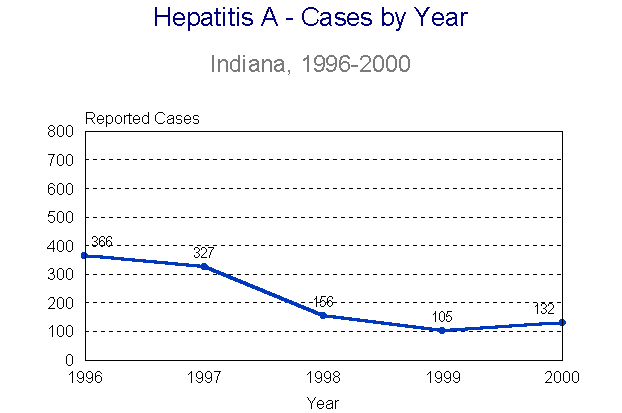
2000 Indiana Report of Infectious Diseases |
View ISDH's Quick Facts on Hepatitis A
View CDC's Hepatitis A page
Rates presented are per 100,000 population and are based on the U.S. 2000 Census.
| Cases | Incidence Rate |
|
| Total | 132 | 2.2 |
| Race-specific cases and rates1 | ||
| White | 88 | 1.7 |
| Black | 33 | 6.5 |
| Other2 | 2 | *0.802 |
| Sex-specific cases and rates | ||
| Female | 42 | 1.4 |
| Male | 90 | 3.0 |
Hepatitis A is a viral infection most commonly transmitted by fecally contaminated food or water, or from person-to-person via fecally contaminated hands or oral-anal contact. Hepatitis A virus is found primarily in humans.
In 2000, 132 cases of hepatitis A were reported in Indiana, representing a 26% increase over the 1999. However, the incidence remained below the 1995-1999 average incidence of 228 cases (Figure HpA1). The number of reported cases was highest during the late summer and fall months (Figure HpA2).
In 2000, data indicate that blacks were 3.8 times more likely than whites to become infected with hepatitis A. Male cases (3.0 per 100,000 population) were more than twice as likely to be reported than female cases (1.4). Age-specific rates were highest among adults ages 20-29 years (3.4) followed by adults aged 30-39 years (3.1), and children ages 5-9 years old (2.9) (Figure HpA3).
Among counties with at least 5 cases reported, the incidence rates were highest in Howard (9.4 per 100,000 population), Lake (8.1) and Porter (7.5) Counties.
The most commonly reported risk factor for hepatitis A infection was contact with a known case. Approximately 29% of the interviewed cases reported prior contact with a case, most commonly through household or sexual contact. Other common risk factors included male homosexual/bisexual contact (17%) and international travel (11%). Fifteen (11%) of the interviewed cases were employed as foodhandlers during their infections. The reported risk factor data are summarized in Table HpA1.
No outbreaks of hepatitis A infection were reported in Indiana in 2000. However, in October, one case of hepatitis A was identified in a foodhandler who worked while infectious at two franchise restaurants in Marion and Johnson Counties. Over 3,000 doses of immune globulin were distributed to citizens who met the exposure criteria.
Back to Top of Article
Back to Table of Contents
|
|
Back to Reference in Text
Back to Top of Article
|
|
Back to Reference in Text
Back to Top of Article
|
Figure HpA3: Hepatitis A - Incidence Rate by Age Group, Indiana, 1996-2000 |
|
|
Back to Reference in Text
Back to Top of Article
|
||||||||||||||||||||||||||||||||||||||||||||||||||||||||||||||||||||||||||||||||||||||||||||||||
Back to Reference in Text
Back to Top of Article
1 - Race was unknown for 132 of the reported cases.
2 - "Other" includes American Indian/Alaska Native, Asian, Native Hawaiian/Pacific Islander, and multiracial.
* - Rate based on less than 20 cases and should be considered unstable.
Back to Table of Contents
[an error occurred while processing this directive]